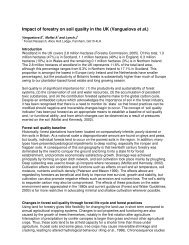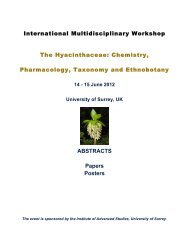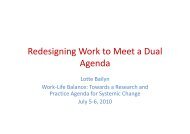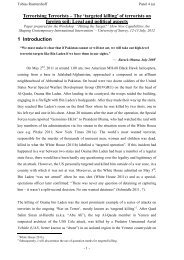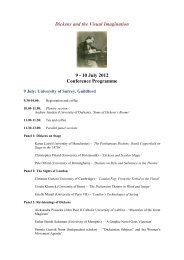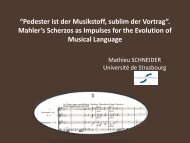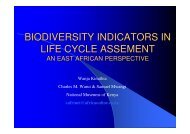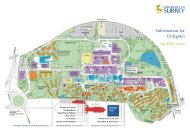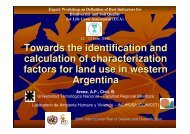2101-0609 Mobility and Creativity Programme ver2.indd - Institute of ...
2101-0609 Mobility and Creativity Programme ver2.indd - Institute of ...
2101-0609 Mobility and Creativity Programme ver2.indd - Institute of ...
Create successful ePaper yourself
Turn your PDF publications into a flip-book with our unique Google optimized e-Paper software.
<strong>Mobility</strong> <strong>and</strong> <strong>Creativity</strong>:<br />
Narrative, Representation <strong>and</strong> Performance<br />
3 - 4 July 2009<br />
<strong>Programme</strong> • Abstracts • Speakers<br />
<br />
A two-day international workshop hosted by<br />
the Department <strong>of</strong> English, University <strong>of</strong> Surrey<br />
Sponsored by: <strong>Institute</strong> <strong>of</strong> Advanced Studies<br />
<strong>2101</strong>-<strong>0609</strong> <strong>Mobility</strong> <strong>and</strong> <strong>Creativity</strong> <strong>Programme</strong> <strong>ver2.indd</strong> 1 24/6/09 10:40:32
<strong>2101</strong>-<strong>0609</strong> <strong>Mobility</strong> <strong>and</strong> <strong>Creativity</strong> <strong>Programme</strong> <strong>ver2.indd</strong> 2 24/6/09 10:40:32
<strong>Programme</strong><br />
Mobilities has increasingly become central to the analysis <strong>of</strong> social relations in contemporary society where it <strong>of</strong>ten<br />
appears that ‘all the world is on the move,’ from the movement <strong>of</strong> diasporas, tourists, migrants <strong>and</strong> refugees. While<br />
the emergence <strong>of</strong> this new ‘mobility paradigm’ (Sheller <strong>and</strong> Urry, 2006; Urry 2002, 2007) originated within the social<br />
sciences, this conference focuses on how such a ‘mobility turn’ has been narrated, represented <strong>and</strong> performed within<br />
the arts <strong>and</strong> humanities. The two-day international conference aims to explore creative responses to these diverse<br />
mobilities in literature, art, film, <strong>and</strong> theatre for example. How have these complex mobilities been negotiated <strong>and</strong><br />
critiqued through creative practice? Is creativity dependent upon mobility?<br />
www.surrey.ac.uk 3<br />
<strong>2101</strong>-<strong>0609</strong> <strong>Mobility</strong> <strong>and</strong> <strong>Creativity</strong> <strong>Programme</strong> <strong>ver2.indd</strong> 3 24/6/09 10:40:32
Timetable<br />
Friday 3 July - Saturday 4 July<br />
All sessions will take place in CEC, which is located on the 2nd floor <strong>of</strong> Senate House<br />
Friday 3 July<br />
9am - 9.30am<br />
9.30am - 9.45am<br />
9.45am - 10.45am<br />
10.45am - 12.15pm<br />
12.15pm - 12.45pm<br />
12.45pm - 1.45pm<br />
1.45pm - 2.45pm<br />
2.45pm - 4.15pm<br />
4.15pm - 4.30pm<br />
4.30pm - 5.30pm<br />
5.30pm - 6.30pm<br />
7.30pm<br />
Registration <strong>and</strong> C<strong>of</strong>fee<br />
Welcome<br />
Keynote Lecture<br />
Pr<strong>of</strong>essor John Urry<br />
‘<strong>Mobility</strong> Futures’<br />
Panel 1: Postcolonial Encounters<br />
Panel 2: <strong>Mobility</strong> <strong>and</strong> Aesthetics<br />
Talk by Elly Clarke<br />
Lunch<br />
Keynote Lecture<br />
Pr<strong>of</strong>essor Ginette Verstraete<br />
‘Movement, Convergence <strong>and</strong> <strong>Creativity</strong>: A Critical Introduction’<br />
Panel 3: Asylum <strong>and</strong> Refugees<br />
Panel 4: Cinema <strong>of</strong> Borders<br />
C<strong>of</strong>fee break<br />
Keynote Cabaret<br />
Pr<strong>of</strong>essor Reina Lewis<br />
‘W<strong>and</strong>ering Wardrobes: the pleasures, dangers, <strong>and</strong> indeterminacies <strong>of</strong> the mobile queer body’<br />
Wine Reception<br />
Dinner at Olivio’s in Guildford<br />
Saturday 4 July<br />
9.30am - 9.45am<br />
9.45am - 11.15am<br />
11.15am - 11.30am<br />
11.30am - 1pm<br />
1pm - 2pm<br />
C<strong>of</strong>fee<br />
Panel 5: Mobile Methods<br />
Panel 6: The Invisible City<br />
C<strong>of</strong>fee break<br />
Panel 7: Creative Dis/Locations<br />
Panel 8: Travel Writing<br />
Lunch & Discussion<br />
4<br />
www.surrey.ac.uk<br />
<strong>2101</strong>-<strong>0609</strong> <strong>Mobility</strong> <strong>and</strong> <strong>Creativity</strong> <strong>Programme</strong> <strong>ver2.indd</strong> 4 24/6/09 10:40:32
Panels <strong>and</strong> Abstracts<br />
Panel 1: Postcolonial Encounters<br />
Corinne Fowler, Lancaster University<br />
‘Replete with danger’: travel writing, news media coverage <strong>and</strong> the history <strong>of</strong> British ideas about Afghanistan.<br />
As the military situation in Afghanistan continues to deteriorate, an investigation <strong>of</strong> recent mainstream news media coverage<br />
reveals the extent to which British travel writing continues to inform <strong>and</strong> influence reporting on ‘Afghan’ conflicts. Despite<br />
researchers’ interest in travel writing’s capacity for experimentation <strong>and</strong> reflexivity, journalists continue to enlist the help <strong>of</strong> travel<br />
narratives in their analyses <strong>of</strong> the present conflict. Since the turn <strong>of</strong> the twentieth century, it has been the well-established habit<br />
<strong>of</strong> travellers to superimpose nineteenth-century contexts <strong>of</strong> traumatic Afghan-British encounter onto contemporary Afghan<br />
settings. This paper examines the way in which travel narratives, which are heavily dependent on the works <strong>of</strong> Rudyard Kipling,<br />
have helped set present day news agendas. Above all, it considers the consequences <strong>of</strong> this reliance.<br />
Patricia Johnson, University <strong>of</strong> Newcastle, Australia<br />
The Politics <strong>of</strong> L<strong>and</strong>scape<br />
Adventure <strong>and</strong> imagination are constant companions in creating l<strong>and</strong>scapes <strong>and</strong> geographies in travel writing. In narratives <strong>of</strong><br />
mobility the ‘arrival’ scene appears as a defining moment: one must cross a threshold <strong>and</strong> maintain a movement or passage<br />
which involves the temporal <strong>and</strong> spatial dimensions <strong>of</strong> liminality. The travel writer <strong>of</strong>ten documents this point as a defining,<br />
<strong>and</strong> sometimes dramatic, moment <strong>and</strong> how they script this moment tells the reader much about how the rest <strong>of</strong> the story will<br />
be framed. The liminal space <strong>of</strong> the traveller is a personal space <strong>and</strong> deeply influenced by preconceived notions about place<br />
– notions which influence the position from which the traveller assumes to view the foreign. The author casts a gaze from a<br />
particular ‘viewing platform’ which is informed by Western discourse <strong>and</strong> engages aesthetic dimensions <strong>of</strong> time <strong>and</strong> space to<br />
position the liminal in the narrative. This paper examines the writings <strong>of</strong> three women authors who wrote about their travels<br />
to the Islamic Republic <strong>of</strong> Iran. These writings are set within in a particular historical moment – between the Islamic Revolution<br />
<strong>and</strong> U.S. President Bush’s ‘Axis <strong>of</strong> Evil’ declaration in 2002. Examples <strong>of</strong> texts are used to explore the various ways the writers<br />
frame their narratives according to the ‘I’ <strong>of</strong> the self who focuses the ‘eye’ (gaze) through a lens oriented by their cosmopolitical<br />
imagination or worldview. The texts are analysed by positioning the narrator as an aesthetic cosmopolitan figure who discursively<br />
constructs a gaze over the l<strong>and</strong>scape by mobilising notions <strong>of</strong> gender <strong>and</strong> power. Political imageries <strong>and</strong> political discourse are<br />
not only used as metaphors to describe l<strong>and</strong>scapes but also appear as devices to build character as cosmopolitan traveller.<br />
Nishevita Murthy <strong>and</strong> Sudha Shastri, Indian <strong>Institute</strong> <strong>of</strong> Technology Bombay, India<br />
Politics <strong>of</strong> the Headscarf in Orhan Pamuk’s Snow<br />
Our paper considers mobility with respect to the peregrination <strong>of</strong> cultural symbols, namely the female headscarf, deriving its<br />
argument from Pamuk’s novel Snow (2002), which explores a series <strong>of</strong> suicides among young girls in the 1990s, in the town<br />
<strong>of</strong> Kars in Turkey. The suicides bring to light a conflict raging between the government’s injunction to women forbidding<br />
headscarves, <strong>and</strong> the will <strong>of</strong> these women to retain them as part <strong>of</strong> their identity. This phenomenon is investigated by the<br />
protagonist Ka, a young Turkish political exile, returning from Germany after twelve years ostensibly to report on this event; who<br />
gets embroiled in the debates surrounding the suicides. Are the suicides simply retaliation by women to the orchestration <strong>of</strong> their<br />
lives by ideologues, or can they be interpreted as acts <strong>of</strong> agency?<br />
We examine how ideas transform through displacement. At one level, the connotations <strong>of</strong> the headscarf change dramatically<br />
from East to West <strong>and</strong> back, accruing layers <strong>of</strong> meaning from its movement. What becomes a symbol <strong>of</strong> tradition in Turkey is<br />
interpreted as a symbol <strong>of</strong> constraint in Germany. Ka, a traveler <strong>and</strong> the reader’s point <strong>of</strong> identification in the novel, becomes a<br />
prism through which gender constructions are filtered to reveal the politics <strong>of</strong> representation.<br />
The second level <strong>of</strong> movement involves oscillation <strong>of</strong> the headscarf between the private <strong>and</strong> public realms. From a personal<br />
symbol <strong>of</strong> ritual piety, the headscarf comes to be dramatized in the form <strong>of</strong> a play called ‘My Fatherl<strong>and</strong> or My Headscarf’<br />
in Snow, thereby driven by ideology within the public space. Besides adding the dimension <strong>of</strong> spectacle to the debate, this<br />
reinvention presupposes an audience, <strong>and</strong> raises the possibility <strong>of</strong> deliberateness. Our paper takes the argument ahead by<br />
considering the implications <strong>of</strong> the metaphor <strong>of</strong> theatre <strong>and</strong> performance in this debate, as the personal <strong>and</strong> the political<br />
intersect.<br />
www.surrey.ac.uk 5<br />
<strong>2101</strong>-<strong>0609</strong> <strong>Mobility</strong> <strong>and</strong> <strong>Creativity</strong> <strong>Programme</strong> <strong>ver2.indd</strong> 5 24/6/09 10:40:32
Panels <strong>and</strong> Abstracts<br />
Panel 2: <strong>Mobility</strong> <strong>and</strong> Aesthetics<br />
Stefan Höhne, Centre for Metropolitan Studies, Germany<br />
The Perception <strong>of</strong> the Passenger: Transitory practices <strong>and</strong> perceptions in works by Hopper, Cornell <strong>and</strong> Gondry<br />
Through industrialized infrastructures <strong>of</strong> mobility, the experience <strong>of</strong> transit became an essential part <strong>of</strong> everyday life, constituting<br />
the figure <strong>of</strong> the modern passenger. New cultural techniques <strong>and</strong> modes <strong>of</strong> perception emerged, altering performance <strong>and</strong><br />
sensual habits. The transitory perceptions <strong>and</strong> practices <strong>of</strong> the passenger where constituted by <strong>and</strong> constitutive for studies <strong>of</strong><br />
phenomenology <strong>and</strong> the arts in the 20th century. Drawing on works by Edward Hopper, Joseph Cornell <strong>and</strong> Michel Gondry,<br />
my presentation will deal with the ways these phenomena are reflected on in visual art. Foremost, I will focus on how these<br />
perceptions are constituted in relation to the interior <strong>of</strong> transit vehicles (Hopper), the interrelations <strong>of</strong> transit vehicle <strong>and</strong> space<br />
(Cornell) <strong>and</strong> the perception <strong>of</strong> transit space itself (Gondry). Edward Hoppers paintings “Compartment C, Car 193” (1938) <strong>and</strong><br />
“Chair Car” (1965) emphasize the spatial codes <strong>and</strong> materialities <strong>of</strong> transit interiors in its relations to techniques <strong>of</strong> gazing <strong>and</strong><br />
interaction as well as the phenomenon <strong>of</strong> reading in transit. In his film “Gnir Rednow” (1955) Joseph Cornell deals with the<br />
passengers’ experience <strong>of</strong> de<strong>and</strong> reterretorialization (Deleuze) in a New York subway train. By capturing the reflections in the<br />
windows, Cornell creates effects <strong>of</strong> superimpositions <strong>and</strong> blurring between transit vehicle <strong>and</strong> transit space. Finally, I will discuss<br />
the transitory perception <strong>of</strong> the passenger by looking at the work “Star Guitar” (2001) by the French visual artist Michel Gondry.<br />
In this animated film, Gondry intertwines the gaze on urban transit space with the acoustic experience <strong>of</strong> repetition <strong>and</strong> rhythm.<br />
By relating these artistic approaches towards the modes <strong>of</strong> perceptions in transit <strong>and</strong> linking them with academic works by<br />
Simmel, G<strong>of</strong>fman <strong>and</strong> Husserl, among others, I will show how the experience <strong>of</strong> transit <strong>and</strong> mobility shaped artistic practice in<br />
both modes <strong>of</strong> production <strong>and</strong> inspiration.<br />
Emma Cocker, Nottingham Trent University<br />
From Passivity to Potentiality: The Communitas <strong>of</strong> Stillness<br />
Referring to my collaboration with the artist-led project, Open City, I will investigate the (im)mobility <strong>of</strong> stillness as a creative<br />
strategy. I will explore the potential <strong>of</strong> an active <strong>and</strong> resistant - rather than passive or acquiescent - form <strong>of</strong> stillness that can be<br />
activated strategically within a performance-based practice; in turn producing conditions in which a radically dissenting - yet<br />
affirmative - model <strong>of</strong> subjectivity might be developed. Stillness is <strong>of</strong>ten presented as antithetical to the velocity, mobility, speed<br />
<strong>and</strong> freedom proposed by new technologies <strong>and</strong> the various accelerated modes by which we are encouraged to engage with<br />
the world. Stillness <strong>and</strong> slowness have been deemed outmoded or anachronistic forms <strong>of</strong> mobility, as fastness <strong>and</strong> efficiency<br />
have become the privileged terms. Alternatively, stillness has been reclaimed within a resistant - or at least reactive - “counterculture”<br />
for challenging the enforced <strong>and</strong> increased pace that we are required to perform. Rather than focusing on a model <strong>of</strong><br />
stillness based on the attempt to ‘opt out’ <strong>of</strong> the accelerated time-zones, mobilities <strong>and</strong> narratives <strong>of</strong> contemporary capitalism<br />
- the move towards a more spiritual or meditative existence by removal or denial <strong>of</strong> contemporary societal pressures - this paper<br />
will explore the potential within forms <strong>of</strong> stillness specifically produced in <strong>and</strong> by contemporary capitalism, by reflecting on<br />
how they might be (re)inhabited as sites <strong>of</strong> critical action. With reference to the writing <strong>of</strong> Gilles Deleuze - especially in relation<br />
to Spinoza’s Ethics - I want to explore how the asignifying or affective possibilities produced by the collective performance <strong>of</strong><br />
stillness can be understood as a mode <strong>of</strong> playful resistance to or refusal <strong>of</strong> habitual social norms; additionally producing the<br />
germinal conditions for a nascent community <strong>of</strong> experience no longer bound by existing protocol, a model <strong>of</strong> “communitas”<br />
emerging from the shared act <strong>of</strong> being still.<br />
6<br />
www.surrey.ac.uk<br />
<strong>2101</strong>-<strong>0609</strong> <strong>Mobility</strong> <strong>and</strong> <strong>Creativity</strong> <strong>Programme</strong> <strong>ver2.indd</strong> 6 24/6/09 10:40:32
Panels <strong>and</strong> Abstracts<br />
Petra Hroch, University <strong>of</strong> Alberta, Canada<br />
<strong>Mobility</strong> <strong>and</strong> Critique in Paul Klee’s “Creative Writing”<br />
Swiss-born artist Paul Klee (1879-1940) is known primarily for his work as a painter. Klee is also known for having been a<br />
formative instructor at the Bauhaus in Germany from 1921 until 1931, when his work there became increasingly difficult due to<br />
the rise <strong>of</strong> the Nazi party (the Bauhaus was closed down by the Nazis in 1933). Although Klee is well-known for his contribution<br />
to visual art during this period, he less widely recognized – despite his prolific theoretical writings – for his work as a theorist. A<br />
closer examination <strong>of</strong> Klee’s written work demonstrates, however, that he has much to contribute to the contemporary “turn to<br />
mobility.”<br />
In his writing, Klee likened artistic creation to the processes <strong>of</strong> genesis in nature – he saw the created <strong>and</strong> the creative world<br />
as being fundamentally related through mobility, movement, <strong>and</strong> performance. For Klee, “movement is at the very root <strong>of</strong><br />
all becoming” (Güse 146). The many dancers, singers, acrobats, puppets <strong>and</strong> other actors that Klee drew <strong>and</strong> painted (most<br />
recently exhibited together in the 2007 collection entitled Überall Theater [Theatre Everywhere] at the Zentrum Paul Klee in Bern)<br />
demonstrate that Klee was interested in performing <strong>and</strong> theatrical figures as a way <strong>of</strong> making visually explicit that his canvases<br />
were performance spaces that played out the “all-embracing ‘movement’ that governs the entire cosmos” (Güse “Foreword”).<br />
This paper focuses on Klee’s “creative” writing – that is, his theoretical reflections on the creative process – that so informed<br />
his artistic practice (<strong>and</strong> aspects <strong>of</strong> which Gilles Deleuze <strong>and</strong> Félix Guattari have emphasized in A Thous<strong>and</strong> Plateaus). I examine<br />
Klee’s reflections in his critical <strong>and</strong> quirky published diaries, his engaging personal letters, <strong>and</strong> his theoretically rich pedagogical<br />
notebooks in order to underst<strong>and</strong> how his textual narratives <strong>and</strong> very “performative” visual practices inform one another. I<br />
bring together Klee’s written work <strong>and</strong> visual art to show how mobility is fundamental to his theory <strong>of</strong> creativity, <strong>and</strong> even more<br />
importantly, how his thinking about creativity in terms <strong>of</strong> mobility contributes to a critical practice. What is critical about Klee’s<br />
work is that the movement that underlies the creative process gives rise to a constant negotiation between the everyday, the<br />
“given,” or the created world, <strong>and</strong> the creative, the new, <strong>and</strong> the possible.<br />
www.surrey.ac.uk 7<br />
<strong>2101</strong>-<strong>0609</strong> <strong>Mobility</strong> <strong>and</strong> <strong>Creativity</strong> <strong>Programme</strong> <strong>ver2.indd</strong> 7 24/6/09 10:40:32
Panels <strong>and</strong> Abstracts<br />
Panel 3: Asylum <strong>and</strong> Refugees<br />
Alex Rotas, University <strong>of</strong> Cardiff<br />
Necessary Journeys: Visual Explorations by Contemporary Artists from Refugee Populations in the UK<br />
This visual paper draws on research into the work <strong>of</strong> visual artists who have come to the UK as refugees or asylum seekers<br />
over the last 30 years. As well as considering the range <strong>of</strong> ways that visual artists have responded to their experience <strong>of</strong> forced<br />
mobility, it addresses the reception their work has been given by the UK art academy.<br />
Refugee artists have explored their experiences in their practice in various ways, including focusing on the events leading to<br />
their flight, the responses they received on arrival in the UK ‘host-nation’, their feelings <strong>of</strong> nostalgia, or <strong>of</strong> alienation or <strong>of</strong> the<br />
complexity <strong>of</strong> negotiating their own, now multiple, identities. Some artists may appear to ignore any personal experiences in<br />
their artwork, remaining preoccupied with aesthetic issues. Alternatively, or additionally, they may celebrate the contrapuntal<br />
feelings <strong>and</strong> opportunities that seeking refuge in another culture has opened up for them.<br />
How have funders, curators, critics <strong>and</strong> viewers responded to this variegated body <strong>of</strong> work? In a climate dominated by the<br />
politics <strong>of</strong> cultural diversity, ‘otherness’ has been prioritised in terms <strong>of</strong> funding from the Arts Council. Emphasising difference<br />
has meant that foreign-born artists have found themselves simultaneously supported <strong>and</strong> marginalised. They have been able<br />
to obtain financial support by drawing attention to their ethnic roots, but showing their work as ‘Iraqi artists’ or ‘asylum artists’<br />
has marginalised them by keeping them separate from the mainstream occupied by ‘artists’ pure <strong>and</strong> simple. Recently, however,<br />
major exhibitions <strong>of</strong> ‘British art’ have defined British artists as those living <strong>and</strong> practising in the UK. This curatorial shift suggests<br />
an encouraging <strong>and</strong> more generous definition <strong>of</strong> Britishness that embraces all artists working in the UK, irrespective <strong>of</strong> why,<br />
when or from where they came. This move impacts significantly on both artists <strong>and</strong> viewers alike.<br />
Francis Maravillas, University <strong>of</strong> Technology, Australia<br />
Geography <strong>and</strong> the Politics <strong>of</strong> <strong>Mobility</strong> in Contemporary Art<br />
In 2001, a Norwegian cargo ship, the M.V. Tampa, rescued over four hundred refugees from a boat that had began to sink <strong>of</strong>f<br />
the Indonesian archipelago en route to Australia. As the Tampa made its way towards the isl<strong>and</strong>-continent, it was refused entry<br />
into Australian waters by a government declaring it was not “a s<strong>of</strong>t touch <strong>and</strong> [not one] whose sovereign rights in relation to<br />
who comes here are going to be trampled on”. Within days, the image <strong>of</strong> the giant ochre hulk <strong>of</strong> the Tampa was projected onto<br />
the national imaginary, etching itself against a national consciousness already inured to – though still prone to panic at the sight<br />
<strong>of</strong> – the flotilla <strong>of</strong> rickety boats packed with people heading south towards Australian shores.<br />
In this paper, I present a number <strong>of</strong> ‘frames’ through which the passage <strong>of</strong> the Tampa may be viewed. In particular, I examine<br />
selected works <strong>of</strong> contemporary artists in order to show how the issues <strong>of</strong> mobility <strong>and</strong> migration overlap <strong>and</strong> converge with the<br />
wider questions <strong>of</strong> space, place <strong>and</strong> identity in an increasingly globalised world. I argue that these ‘frames’ represent crucial sites<br />
for articulating <strong>and</strong> enacting a politics <strong>of</strong> mobility <strong>and</strong> spatiality, one that attends to the ways in which the space <strong>of</strong> ‘Australia’<br />
may been imagined not as an enclaved territory; but as an evolving cartography, constructed out <strong>of</strong> a particular constellation<br />
<strong>of</strong> relations <strong>and</strong> trajectories that come together at a particular site, but are defined within a wider network <strong>of</strong> vectors, both<br />
local <strong>and</strong> global, past <strong>and</strong> present. In so doing, I wish to activate a mode <strong>of</strong> inquiry that draws on the insights <strong>of</strong> the ‘mobility<br />
paradigm’, while re-asserting the centrality <strong>of</strong> spatial thinking to an underst<strong>and</strong>ing <strong>of</strong> recent representations <strong>of</strong> mobility in<br />
contemporary art.<br />
Sarah Gibson, University <strong>of</strong> Surrey<br />
Testimony in a Culture <strong>of</strong> Disbelief: Staging Asylum Drama in Britain<br />
The ability to bear witness is crucial for those forced migrants who seek asylum in Britain. Within the context <strong>of</strong> a wider ‘culture<br />
<strong>of</strong> disbelief’, those others are <strong>of</strong>ten greeted with suspicion <strong>and</strong> are categorised as ‘bogus’ asylum seekers if they cannot provide<br />
credible testimony in support <strong>of</strong> their application. Despite the importance <strong>of</strong> such narratives, testimonies <strong>and</strong> life stories, asylum<br />
seekers are frequently silenced <strong>and</strong> rendered speechless within the public sphere. The aporia <strong>of</strong> bearing witness is dramatised<br />
in Kay Adshead’s The Bogus Woman <strong>and</strong> Timberlake Wertenbaker’s Credible Witness in order to reveal the hostile conditions<br />
in Britain <strong>and</strong> the impossibility <strong>of</strong> testifying to a ‘well-founded fear <strong>of</strong> persecution’ in the process <strong>of</strong> seeking asylum. This article<br />
examines the ethics <strong>and</strong> politics <strong>of</strong> speaking <strong>and</strong> hearing life stories following Jacques Derrida’s ethical writings on hospitality,<br />
testimony, <strong>and</strong> witnessing.<br />
8<br />
www.surrey.ac.uk<br />
<strong>2101</strong>-<strong>0609</strong> <strong>Mobility</strong> <strong>and</strong> <strong>Creativity</strong> <strong>Programme</strong> <strong>ver2.indd</strong> 8 24/6/09 10:40:32
Panels <strong>and</strong> Abstracts<br />
Panel 4: Cinema <strong>of</strong> Borders<br />
Elisa Antz, Justus Liebig University, Germany<br />
Root Trips: Tony Gatlif’s movie Exiles as a contemporary “geneobile” journey<br />
In this presentation, I will focus on the movie Exiles written, directed <strong>and</strong> produced by Tony Gatlif in 2004. In generic terms, one<br />
might consider Exiles as an example <strong>of</strong> cinema’s most prototypical representation <strong>of</strong> mobility, that is to say as a Road Movie.<br />
The film depicts the adventurous journey <strong>of</strong> Zano <strong>and</strong> Naima, a young <strong>and</strong> rather unruly couple, who are headed from Paris to<br />
Algeria. However, motivation, direction, <strong>and</strong> representation <strong>of</strong> the trip differ significantly from an accelerating journey into an<br />
unknown future. Rather, Zano <strong>and</strong> Naima have a concrete destination, which lies in the geographical distance, as well as in the<br />
chronological past. The two children <strong>of</strong> Algerian émigrés travel to their ancestors’ homel<strong>and</strong>, desiring to awaken memories <strong>and</strong><br />
reconnect to their family roots. By seeking their genealogical roots, the protagonists traverse current borders <strong>and</strong> foreign spaces.<br />
Thus, Exiles represents a peculiar ‘genealogical-mobile’ kind <strong>of</strong> journey narrative – what I call a ‘geneobile’ Root Trip.<br />
While anthropologist Paul Basu has already written on the cultural phenomenon <strong>of</strong> “roots-tourism”, I am interested in the<br />
stylistic devices that narrate the ‘geneobile’ trip. ‘Accented cinema’ which film scholar Hamid Naficy conceptualizes as featuring<br />
“home-seeking journeys, journeys <strong>of</strong> homelessness, <strong>and</strong> homecoming journeys” that “are also deeply psychological <strong>and</strong><br />
philosophical”(Naficy 2001), form a theoretical <strong>and</strong> analytical background for my investigation.<br />
To examine the specificities <strong>of</strong> Exiles as ‘geneobile’ Root Trip, the presentation will focus on three major stages <strong>of</strong> mobility:<br />
• The start – How is the journey motivated? How do distance <strong>and</strong> past interrelate?<br />
• The journey – What are the most remarkable devices depicting this trip? How is mobility portrayed <strong>and</strong> (how) do these<br />
representations say anything about contemporary processes <strong>of</strong> identification?<br />
• The end – Can one speak <strong>of</strong> a ‘home-coming’ or <strong>of</strong> an arrival?<br />
Hing Tsang, University <strong>of</strong> Surrey<br />
The mobile phone, mobility, <strong>and</strong> war in Van der Keuken’s Amsterdam Global Village<br />
This paper considers how both mobility <strong>and</strong> cosmopolitanism has <strong>and</strong> can be represented through transnational documentary<br />
film. We explore this through the work <strong>of</strong> the late Dutch filmmaker Van der Keuken whose film Amsterdam Global Village<br />
(1994) featured emigration back <strong>and</strong> forth between his own home city Amsterdam <strong>and</strong> different parts <strong>of</strong> the world. This film<br />
was a documentary made on the move, a post-modern road movie which featured air travel, canals <strong>and</strong> computer screens<br />
- gadgets large <strong>and</strong> small in age <strong>of</strong> both corporeal <strong>and</strong> social mobility. It engages very much with the ideas <strong>of</strong> openess <strong>and</strong><br />
multiculturalism (Hannerz, 1996), paying more than lip service to McLuhan’s earlier ideas <strong>of</strong> ‘all-at-onceness’ (1962).<br />
This paper looks at one particular narrative which is juxtaposed amongst many other narratives <strong>of</strong> travel. We analyse one str<strong>and</strong><br />
featuring a Chechenian emigrant <strong>and</strong> businessman, whose business involves the mobile phone <strong>and</strong> travel within Amsterdam,<br />
<strong>and</strong> eventually a return to his native war-stricken Chechenia. We propose that this particular moment, which is emblematic <strong>of</strong><br />
Van der Keuken’s overall world view, both upholds current ideas about hyper-modernity <strong>and</strong> mobility, while also reminding us<br />
that the human agent exists within limited biological cycles, that the continued existence <strong>of</strong> genetic biological ties are, pace<br />
Pinker (2002) Wilson (1998), strengthened rather than weakened in an age <strong>of</strong> technological mobility.<br />
www.surrey.ac.uk 9<br />
<strong>2101</strong>-<strong>0609</strong> <strong>Mobility</strong> <strong>and</strong> <strong>Creativity</strong> <strong>Programme</strong> <strong>ver2.indd</strong> 9 24/6/09 10:40:32
Panels <strong>and</strong> Abstracts<br />
Therefore, could it be possible that human mobility <strong>and</strong> an increasing number <strong>of</strong> technical gadgets are literally ‘an extension <strong>of</strong><br />
man’ in a way that McLuhan had not imagined or articulated, <strong>and</strong> this might now serve instead to remind us <strong>of</strong> what man is. The<br />
emergence <strong>of</strong> hyper-modernity <strong>and</strong> virtuality then does not remove us into some equivalent <strong>of</strong> ‘timeless time’ Castells (1999),<br />
but in some cases as suggested here by Van der Keuken remind us <strong>of</strong> our own mortality, <strong>and</strong> the affective <strong>and</strong> biological ties<br />
which link ourselves to other human beings.<br />
Arne Saeys, University <strong>of</strong> Amsterdam / Kadir Has University Istanbul<br />
Migrant Filmmakers <strong>and</strong> the Creative Economy. A comparison between Brussels <strong>and</strong> Amsterdam<br />
Hamid Naficy (2001) described how exilic <strong>and</strong> diasporic filmmakers translate their personal experiences <strong>of</strong> displacement into<br />
what he called ‘an accented cinema’. The notions <strong>of</strong> exile <strong>and</strong> diaspora, including the dichotomy between host <strong>and</strong> home<br />
societies, can be criticized from the perspective <strong>of</strong> mobilities <strong>and</strong> post-society sociology (Urry 2000). Migration seems to be<br />
only one aspect on a continuum <strong>of</strong> mobility types including tourism, virtual travels <strong>and</strong> other movements. In this paper, I want<br />
to present a different view on migrant filmmakers. Instead <strong>of</strong> looking at migrant filmmakers as ‘exilic’, ‘diasporic’ or ‘ethnic’,<br />
I take the cultural economy as a starting point. In contemporary metropolitan cities, mass production has declined in favor<br />
<strong>of</strong> an economy where more <strong>and</strong> more ‘cultural goods’ are produced <strong>and</strong> consumed (Lash & Urry, 1994). The production <strong>and</strong><br />
consumption <strong>of</strong> unique symbolic experiences has attracted the attention <strong>of</strong> the United Nations (2008) who recognized the<br />
importance <strong>of</strong> creativity <strong>and</strong> cultural diversity for the growth <strong>of</strong> the global economy.<br />
My hypothesis is that the cultural economy with its dem<strong>and</strong> for unique if not exotic images creates opportunities for migrant<br />
filmmakers. By crossing boundaries, migrants are expected to produce new ways <strong>of</strong> thinking, seeing, imagining <strong>and</strong> creating.<br />
Therefore, migrants can be called ‘intercultural innovators’ (Bloomfield & Bianchini 2004). Using the theoretical framework <strong>of</strong><br />
migrant entrepreneurship (Rath & Kloosterman, 2000), I investigate how migrant filmmakers use their social, human <strong>and</strong> cultural<br />
capital to pursue a career in local <strong>and</strong> global film industries. I argue that migrants who are exploiting their transnational networks<br />
have more chances to make a career as a filmmaker than those who do not use these mobilities. In order to point out how local<br />
cultural policies shape the content <strong>and</strong> the narratives <strong>of</strong> migrant filmmakers, I compare filmmakers in two smaller world cities,<br />
Brussels <strong>and</strong> Amsterdam, <strong>and</strong> their links to other places in the world.<br />
10 www.surrey.ac.uk<br />
<strong>2101</strong>-<strong>0609</strong> <strong>Mobility</strong> <strong>and</strong> <strong>Creativity</strong> <strong>Programme</strong> <strong>ver2.indd</strong> 10 24/6/09 10:40:32
Panels <strong>and</strong> Abstracts<br />
Panel 5: Mobile Methods<br />
Corinne Fowler <strong>and</strong> Robert Crawshaw, Lancaster University<br />
Alternative cartographies <strong>of</strong> social space: using literary narratives <strong>of</strong> migration in social science research<br />
As the blurred boundaries between documentary, memory <strong>and</strong> ‘re-imaginings’ <strong>of</strong> personal experience have become more<br />
intensively theorized, creative writing is re-emerging as an important potential resource for Social Science research. This is<br />
especially true with regard to the type <strong>of</strong> mobility entailed in migration. This paper advances a methodology for utilising<br />
creative fiction in mobilities research, arguing that certain types <strong>of</strong> literary text <strong>of</strong>fer fresh perspectives on the overlapping layers<br />
<strong>of</strong> experience which characterise the condition <strong>of</strong> cultural displacement, bringing together the historical, the global <strong>and</strong> the<br />
local within a single, multiply constituted, ‘imagined space’. We argue that such literary accounts can be considered as a data<br />
source in their own right, complementing social science research methodologies grounded in ‘real-life’ observation <strong>and</strong> <strong>of</strong>fering<br />
hypotheses for subsequent ethnographic verification.<br />
Through the narrative processes <strong>of</strong> metaphorical transfer <strong>and</strong> space-time compression, Joe Pemberton’s auto-bio-graphical novel<br />
Forever <strong>and</strong> Ever Amen (2000) demonstrates the potential <strong>of</strong> narratives informed by the experience <strong>of</strong> migration to present<br />
“alternative cartographies <strong>of</strong> social space” (Rouse 1991), most particularly Caribbean Manchester. The social relevance <strong>of</strong> such<br />
narrative representations is further demonstrated by their ‘envelopment’ within mainstream discourses, thereby illustrating how<br />
they ‘articulate’ with existing social norms.<br />
Anu Hirsiaho, University <strong>of</strong> Tampere, Finl<strong>and</strong><br />
On the writing process <strong>of</strong> Paperl<strong>and</strong>: Ethnographic Fiction between Auto-Moments <strong>and</strong> Alienation Effects<br />
Paperl<strong>and</strong> is a fictional saga <strong>of</strong> a Finnish multicultural suburb in transit. Multiculturalism in a peripheral EU country such as<br />
Finl<strong>and</strong> is still a recent entry into the national vocabulary <strong>and</strong> imagery; a much contested set <strong>of</strong> ideas that does not become<br />
accepted overnight. The challenges to multiculturalism do not only rise from the extreme right groups. There are also more<br />
subtle processes <strong>of</strong> exclusion happening at the level <strong>of</strong> everyday life, some <strong>of</strong> which are institutionally produced <strong>and</strong> maintained.<br />
Paperl<strong>and</strong> refers to the machinery that keeps some migrants firmly in the realm <strong>of</strong> re-training <strong>and</strong> third sector employment,<br />
whereas others are not required the same initiation rites into Finnishness <strong>and</strong> Finnish language, based on their higher education<br />
<strong>and</strong> pr<strong>of</strong>essional specialization. In addition to Finnish <strong>and</strong> English language skills, literacy in the Western alphabet is one key<br />
determining factor in defining wanted <strong>and</strong> unwanted new arrivals.<br />
I have chosen to compress the findings <strong>of</strong> my three-year-long fieldwork in the form <strong>of</strong> ethnographic fiction. In this paper, I<br />
discuss the writing process <strong>of</strong> Paperl<strong>and</strong>, <strong>and</strong> the choice between different genres <strong>of</strong> ethnographic writing. On one h<strong>and</strong>, to<br />
what extent do theories <strong>of</strong> auto/ethnography support the writing process, <strong>and</strong>, on the other h<strong>and</strong>, what kinds <strong>of</strong> processes <strong>of</strong><br />
alienation, distancing, or citing Ruth Behar, “tenderminded toughmindedness” are needed to make the text communicate with<br />
various audiences?<br />
www.surrey.ac.uk 11<br />
<strong>2101</strong>-<strong>0609</strong> <strong>Mobility</strong> <strong>and</strong> <strong>Creativity</strong> <strong>Programme</strong> <strong>ver2.indd</strong> 11 24/6/09 10:40:32
Panels <strong>and</strong> Abstracts<br />
Paul Booth, Manchester Metropolitan University<br />
Travel Blogging: Narrative Commodity<br />
…A man is always a teller <strong>of</strong> tales, he lives surrounded<br />
by his stories <strong>and</strong> the stories <strong>of</strong> others, he sees<br />
everything that happens to him through them; <strong>and</strong> he<br />
tries to live his life as if he were recounting it.<br />
But you have to choose: to live or to recount…<br />
Jean-Paul Sartre<br />
In traveller enclaves around the world a tradition <strong>of</strong> verbal storytelling exists. Stories <strong>of</strong> adventure, the authentic <strong>and</strong> the exotic<br />
commodify the travel experience. Drawing on Bourdieu, Desforges discusses travel as a form <strong>of</strong> cultural capital, which serves<br />
as a sign <strong>of</strong> distinction <strong>and</strong> enables the traveller to gain access to elevated social classes both during <strong>and</strong> following the travel<br />
experience. In these ways, cultural capital is viewed almost as a negative, or something that further separates the power class<br />
differential between tourist <strong>and</strong> Other. The obsession with the periphery within travellers ‘is <strong>of</strong>ten bound to the collection <strong>and</strong><br />
appropriation <strong>of</strong> identities <strong>of</strong> the exotic Other, through touristic commodities, experiences <strong>and</strong> stories that collectively lead to<br />
the reconstitution <strong>of</strong> embodied identity’. The adventure therefore commodifies the experience, but further distances itself from<br />
the authentic.<br />
Blogging sites provide us with a simulation <strong>of</strong> the travel journey. The narrative created by the travel blogger is one that<br />
condenses time <strong>and</strong> space to recall <strong>and</strong> give structure to the adventure journey. To quote Jean-Paul Satre ‘For an occurrence to<br />
become an adventure, it is necessary for one to recount it’. For the writer it is the creation <strong>of</strong> the narrative <strong>of</strong> experience that<br />
justifies, <strong>and</strong> gives existence to, the adventure. The travel adventure narrative therefore works on two levels: that <strong>of</strong> the remote<br />
experience <strong>of</strong> travel <strong>and</strong> travel in its actuality. The skill <strong>of</strong> the blogger is to recall these travel narratives that live up to the remote<br />
fantasy by ordering narrative time. For the reader the fantasy <strong>of</strong> travel remains the adventure through the simulation <strong>of</strong> the<br />
experience.<br />
12 www.surrey.ac.uk<br />
<strong>2101</strong>-<strong>0609</strong> <strong>Mobility</strong> <strong>and</strong> <strong>Creativity</strong> <strong>Programme</strong> <strong>ver2.indd</strong> 12 24/6/09 10:40:32
Panels <strong>and</strong> Abstracts<br />
Panel 6: The Invisible City<br />
Lei Chin Pang, University <strong>of</strong> Sussex<br />
An Absent Presence: <strong>Mobility</strong> in Wong Kar Wai’s Cinematic Hong Kong<br />
When urban issues <strong>and</strong> the Hong Kong director Wong Kar Wai’s films are both taken into consideration in cultural studies,<br />
a question is posed: if his films are such key texts to underst<strong>and</strong> contemporary Hong Kong as many scholars <strong>and</strong> critics have<br />
stated, why is the current Hong Kong so <strong>of</strong>ten absent from these films? He has so far made ten films, <strong>of</strong> which only three <strong>of</strong><br />
their narratives happen in the current Hong Kong. The rest <strong>of</strong> his films are either set in a foreign country, as in Happy Together,<br />
or in the past <strong>of</strong> Hong Kong, as in 2046, or even in an imaginary ancient world, as in Ashes <strong>of</strong> Time.<br />
To explore the implication <strong>of</strong> Hong Kong’s absence in the films, I argue that it is necessary for Wong to use the spatial others <strong>and</strong><br />
temporal others to present Hong Kong since it is a city in mobility due to its colonial history, migrant population, <strong>and</strong> its position<br />
in today’s globalization. In other words, Wong’s films are <strong>of</strong>ten the stories about somewhere else because the definition <strong>of</strong> Hong<br />
Kong is better clarified by mobility: travel, migration <strong>and</strong> fluid identity. Hong Kong’s mobility can be seen as pathology—as a<br />
migrant city occupied by the British colonizers, invaded by the Japanese imperialists, h<strong>and</strong>ed-over to the Chinese Communists,<br />
Hong Kong has always been in instability <strong>and</strong> uncertainty with its extraordinary history. However, it is not the only way to<br />
underst<strong>and</strong> Hong Kong’s culture. The culture <strong>of</strong> mobility, homelessness <strong>and</strong> hybridity in Wong’s cinematic Hong Kong is also<br />
common, universal <strong>and</strong> paradigmatic in the age <strong>of</strong> globalization. More radically, Hong Kong’s culture, <strong>of</strong>ten known as a<br />
marginal one, can even be seen as the centre <strong>of</strong> the new culture in our time <strong>of</strong> mobility.<br />
Tai-Chiung Chang, St. John’s University, Taipei, Taiwan<br />
Moving Subjectivity: Rewriting Hong Kong in Wong Kar-wai’s 2046<br />
This study appropriates Rol<strong>and</strong> Barthes <strong>and</strong> Julia Kristeva’s reflections on “writing” to investigate the dialectic structure <strong>of</strong><br />
Wong’s film narrative in 2046 (2004). Wong Kar-wai’s earlier films have shown his obsessive attention to Hong Kong <strong>and</strong> his<br />
autobiographical desire for revising its history. In the Mood for Love (2000) nostalgically represents a 1960s Hong Kong <strong>and</strong><br />
explores the protagonists, Chou <strong>and</strong> Su’s haunting opaque desire <strong>and</strong> love. 2046 continues the nostalgic setting <strong>of</strong> Hong Kong<br />
by Chou’s w<strong>and</strong>ering life in a small hotel in Hong Kong. Later in room 2047 <strong>of</strong> the hotel, Chou finishes his autobiographical<br />
novel about an ideal space <strong>and</strong> time, 2046, “where nothing ever changes.”<br />
Taking Chou’s novel writing as the “poetic element” in Wong’s films, which intermittently displaces Wong’s narrative <strong>of</strong> 1960s<br />
Hong Kong, this study shifts Chou in 2046 from a knight figure <strong>of</strong> the courtly love in IML to what Julia Kristeva calls “subject in<br />
process.” That is, with the sensory codes in Chou’s novel writing such as the scientific dreamscape <strong>of</strong> Hong Kong, the ecstatic<br />
distortion <strong>of</strong> people from Chou’s life in the 1960s, <strong>and</strong> the laggard robot attendant on the express, 2046 displays both Chou’s<br />
repressed inner world <strong>and</strong> the rhythmic patterns <strong>of</strong> his new subjectivity.<br />
In his writing process, Chou comes to realize his unconscious search for the haunting old love. With Chou’s endless search,<br />
Wong explores the wounded minds <strong>of</strong> the people in the post-h<strong>and</strong>over Hong Kong: “how long does it take to leave 2046?”<br />
Wong’s narrative shifts between the turmoil <strong>of</strong> the 1960s <strong>and</strong> the eternal promise <strong>of</strong> 2046 expose his anxiety over Hong Kong’s<br />
uncertain subjectivity after 2046, which is one year before the scheduled end <strong>of</strong> China’s “one country, two systems” agreement<br />
regarding the administration <strong>of</strong> the region. In this sense, the uncertain poetic elements in the film can be Wong’s attempts to<br />
rewrite Hong Kong’s disrupted history.<br />
www.surrey.ac.uk 13<br />
<strong>2101</strong>-<strong>0609</strong> <strong>Mobility</strong> <strong>and</strong> <strong>Creativity</strong> <strong>Programme</strong> <strong>ver2.indd</strong> 13 24/6/09 10:40:32
Panels <strong>and</strong> Abstracts<br />
Nicola Mann, University <strong>of</strong> Rochester, New York, USA<br />
Portal: A Journey through the Subterranean World <strong>of</strong> Daniel Roth’s Cabrini Green Forest<br />
In 2004, Daniel Roth exhibited Cabrini Green Forest at the Donald Young Gallery in Chicago. Roth’s installation included<br />
documentary evidence <strong>of</strong> a mythic forest which exists within a secret underground tunnel connecting the Metropolitan<br />
Correctional Facility in Chicago’s Loop with the Cabrini-Green housing project in the city’s Near North Side. Central to Roth’s<br />
installation is a fibreglass well or, as the artist refers to it, Portal. Portal invites the gallery visitor to cross the threshold to the<br />
subterranean world <strong>and</strong> explore the unseen catacombs below. Accepting Roth’s invitation, my paper interprets a ‘journey’<br />
through the artist’s underground world.<br />
In making clear the relationship between fantastic dislocations <strong>of</strong> space <strong>and</strong> the site specificity <strong>of</strong> the housing project,<br />
Roth identifies a current conflict which is all too real in the hearts <strong>and</strong> minds <strong>of</strong> many Cabrini-Green residents. Today, the<br />
project is filled with heavy-duty demolition equipment in the late stages <strong>of</strong> a ten-year urban renewal initiative entitled The<br />
Plan for Transformation. This $1.6 billion scheme dem<strong>and</strong>s that 60,000 public housing residents move into mixed-income<br />
neighbourhoods scattered around the city.<br />
Ordered to pack up <strong>and</strong> leave behind not only their homes but also lifelong friends <strong>and</strong> support networks, the residents have,<br />
quite literally, had their roots yanked from beneath their feet. Reflecting the scholarship <strong>of</strong> sociologist Mindy Fullilove who<br />
asserts that the relocation process involved in urban renewal causes “root shock,” my paper charts the ’journey’ <strong>of</strong> a community<br />
rising up to defend its turf. From the quiet protests <strong>of</strong> independent shop owners who refuse to sell up to the bulldozing<br />
moneymen, to the dogged determination <strong>of</strong> church leaders who advocate for the preservation <strong>of</strong> local murals, I highlight the<br />
need to recognize some tenants as “spatial actors” who “use the space” <strong>of</strong> public housing as a productive site <strong>of</strong> social action,<br />
mobility <strong>and</strong> hope (Kevin Fox Gotham & Krista Brumley, 2002; Gotham, 2003).<br />
14 www.surrey.ac.uk<br />
<strong>2101</strong>-<strong>0609</strong> <strong>Mobility</strong> <strong>and</strong> <strong>Creativity</strong> <strong>Programme</strong> <strong>ver2.indd</strong> 14 24/6/09 10:40:32
Panels <strong>and</strong> Abstracts<br />
Panel 7: Creative Dis/Locations<br />
Creative practices are inextricable from processes <strong>of</strong> socio-economic mobility. The movement from one place to another,<br />
whether from ‘home’ to ‘host’ or between classed, racialised <strong>and</strong> gendered spaces in the same local or national context, involves<br />
processes <strong>of</strong> dislocation <strong>and</strong> emplacement that not only foreground but are in part constituted by differences in cultural <strong>and</strong><br />
creative practices. Such dis/locations are mobilising forces – comprised <strong>of</strong> productive mobilities that involve meetings between<br />
different practices, paradigms <strong>and</strong> forms that may be ‘alien’ to each other, that are sometimes hostile, sometimes difficult, but<br />
deeply creative, as the complex processes <strong>of</strong> everyday life <strong>and</strong> cultural hybridisation always are. Moreover, such mobilities are<br />
both hampered <strong>and</strong> energised by the movement between the ‘inside’ <strong>and</strong> the ‘outside’ <strong>of</strong> the spaces <strong>of</strong> social <strong>and</strong> cultural<br />
power. These spaces are both tangible <strong>and</strong> intangible; they are inscribed on the physical l<strong>and</strong>scape, in the structures <strong>of</strong><br />
institutions, in the workings <strong>of</strong> the creative industries.<br />
The work that the members <strong>of</strong> this panel are involved with could all be seen as tracing <strong>and</strong> facilitating these mobilities between<br />
‘inside’ <strong>and</strong> ‘outside’ -- that have the aim not <strong>of</strong> the assimilation <strong>of</strong> subaltern creativities to the ‘inside’, but that strive to enable<br />
a lasting mobile process between creative forms, social <strong>and</strong> cultural spaces, disciplines <strong>and</strong> institutions. At the same time, both<br />
mobility <strong>and</strong> creativity, like the ‘projects’ <strong>of</strong> community, identity <strong>and</strong> belonging in which they are <strong>of</strong>ten employed, also require<br />
‘anchoring’, a point <strong>of</strong> fixity. When projects end, do the multiple mobilities engaged <strong>and</strong> produced dissipate? How can the<br />
shifting <strong>and</strong> other-worldly energies <strong>of</strong> creativity <strong>and</strong> mobility be translated into enduring social <strong>and</strong> cultural change?<br />
Nessa O’Mahony, Artist in Residence, John Hume <strong>Institute</strong> <strong>of</strong> Global Irish Studies, University College Dublin<br />
Anne Mulhall, School <strong>of</strong> English, Drama & Film, University College Dublin<br />
Multiple Mobilities <strong>and</strong> the Migrant Woman Writer: The Women Writers in the New Irel<strong>and</strong> Network<br />
The migrant woman writer is multiply mobile: potentially marked by multiple categories <strong>of</strong> ‘otherness’, her movements between<br />
margins <strong>and</strong> centres <strong>of</strong> power are complex <strong>and</strong> diverse. While ‘mobility’ might suggest a straightforwardly positive capability,<br />
this kind <strong>of</strong> mobility, like Chela S<strong>and</strong>oval’s “differential consciousness”, can be hard-won from experiences <strong>of</strong> dislocation<br />
<strong>and</strong> exclusion. The initial journey between home place <strong>and</strong> host country is, perhaps, never finished, but rather continues as a<br />
permanent mobility between multiple material, affective <strong>and</strong> psychic spaces. However difficult, there is much creative potential<br />
intrinsic to such diverse mobilities. Nonetheless, the problems facing the migrant woman writer are as multiple as the mobilities<br />
she engages. How does a woman writer in a new country negotiate the dislocations <strong>and</strong> exclusions she might experience so<br />
that she might continue her creative work? In 2007, the Women Writers in the New Irel<strong>and</strong> (WWINI) Network was established<br />
as a space for the facilitation <strong>of</strong> creative work by migrant women writers in Irel<strong>and</strong>. Drawing on the experiences <strong>of</strong> network<br />
members, as well as <strong>of</strong> those <strong>of</strong> the network facilitators, this paper explores the multiple mobilities that are central to the<br />
network. The network includes women who are positioned very differently in relation to cultural, social <strong>and</strong> political power.<br />
How does the network negotiate these differential experiences <strong>of</strong> dislocation <strong>and</strong> emplacement between the network members<br />
<strong>and</strong> between the women writers <strong>and</strong> network facilitators? How do issues <strong>of</strong> physical mobility impact upon women’s access to<br />
the network? In what way is the work <strong>of</strong> these women writers mobilising change in hegemonic paradigms <strong>of</strong> Irish writing <strong>and</strong><br />
identity? How does the act <strong>of</strong> writing that the network facilitates mobilise energies within the women writers themselves?<br />
Alice Feldman, School <strong>of</strong> Sociology, University College Dublin<br />
Placing Voices, Voicing Places: Community Stories <strong>and</strong> Multicultural Belongings<br />
An interdisciplinary <strong>and</strong> cross-sector collaboration, the Placing Voices, Voicing Places project sought to trace the voices silent<br />
in <strong>and</strong> arguably silenced by the machinations <strong>of</strong> state-based formations central in the reproduction <strong>of</strong> hegemonic notions <strong>of</strong><br />
Irish ‘heritage’, history <strong>and</strong> national identity. Through their narrative <strong>and</strong> artistic renderings gained by means <strong>of</strong> participatory<br />
research methods involving oral history, local folklore, photography <strong>and</strong> digital storytelling, this work illuminates the ‘belongings’<br />
<strong>of</strong> working class ‘locals’ <strong>and</strong> migrants new to the area – what they carry with them <strong>and</strong> what they pass along: what they<br />
remember, keep, perform <strong>and</strong> share on their journeys toward finding their glocalised ‘place’ in contemporary Irish society. Their<br />
stories are marked by both the undercurrents <strong>of</strong> constant change <strong>and</strong> transformation, <strong>and</strong> their capacities to also ‘move’ others<br />
as their tellers negotiate the complex dynamics <strong>and</strong> transitions involved in being both ‘from’ <strong>and</strong> ‘<strong>of</strong>’ a place/s (Brah 1999).<br />
This work also considers the role <strong>of</strong> the local community cultural workers <strong>and</strong> ‘community stewards’ who are endeavouring to<br />
move <strong>and</strong> re/position these voices from the hidden contexts <strong>of</strong> everyday lives into the visible, public arenas <strong>of</strong> local <strong>and</strong> national<br />
debate. Reflecting on both the process <strong>and</strong> the artistic output, this paper explores the role <strong>of</strong> creative agency -- <strong>of</strong> residents,<br />
community practitioners <strong>and</strong> academics -- in terms <strong>of</strong> knowledge outcomes as well as personal transformation, in the cultivation<br />
<strong>of</strong> communities <strong>of</strong> practice <strong>and</strong> belonging.<br />
www.surrey.ac.uk 15<br />
<strong>2101</strong>-<strong>0609</strong> <strong>Mobility</strong> <strong>and</strong> <strong>Creativity</strong> <strong>Programme</strong> <strong>ver2.indd</strong> 15 24/6/09 10:40:32
Panels <strong>and</strong> Abstracts<br />
Ian Russell, Curator, Placing Voices – Voicing Places<br />
Curating Collaborative Heritages: Dissonance, Relational Aesthetics <strong>and</strong> Some Lessons from Inner-City Dublin<br />
Heritage spaces are <strong>of</strong>ten assumed to be ‘from the past’ or ‘just about the past’. Heritage is assumed to be a ‘stoppage’ <strong>of</strong> time.<br />
The choice to create ‘heritage’ is, however, a contemporary decision requiring collaboration <strong>and</strong> social partnership. Through a<br />
recalibration <strong>of</strong> temporal expectations <strong>of</strong> ‘heritages’ or ‘heritage spaces’, the sentiments <strong>of</strong> heritage can be approached as highly<br />
contested, fluid <strong>and</strong> mobile desires to create discursive spaces for the interrogation <strong>and</strong> negotation <strong>of</strong> social life. Approaching<br />
heritage as a contemporary, performative choice within social spaces, this paper will illustrate the value <strong>of</strong> iterative conversations,<br />
relational aesthetics <strong>and</strong> collaboartive arts in the opening <strong>of</strong> heritage spaces to collaborative curation. It will explore synergies<br />
between curatorial practices in both heritage <strong>and</strong> the arts <strong>and</strong> reflect on my growing body <strong>of</strong> curatorial work in contemporary<br />
art undertaken since a departure from academic archaeological theory. A case study will be made <strong>of</strong> the collaborative arts<br />
project ‘Placing Voices – Voicing Places: Dublin’s Contemporary Past’ (www.projecthumedia.com/ucdcp.html). Engaging issues<br />
<strong>of</strong> mobility, dislocation, <strong>and</strong> change inherent to the expressions <strong>of</strong> self <strong>and</strong> community within contemporary life, the project<br />
explored the fluidity <strong>of</strong> heritage spaces <strong>and</strong> the ubiquitous presence <strong>of</strong> ‘heritages’ in the negotiation <strong>of</strong> social spaces in Inner-City<br />
Dublin. More information on my academic <strong>and</strong> curatorial work can be found at: www.iarchitectures.com.<br />
16 www.surrey.ac.uk<br />
<strong>2101</strong>-<strong>0609</strong> <strong>Mobility</strong> <strong>and</strong> <strong>Creativity</strong> <strong>Programme</strong> <strong>ver2.indd</strong> 16 24/6/09 10:40:33
Panels <strong>and</strong> Abstracts<br />
Panel 8: Travel Writing<br />
David Ashford, University <strong>of</strong> Surrey<br />
“Piccadilly Circus is my Playground”: The Birth <strong>of</strong> British Pop Culture in Sam Selvon’s London Underground<br />
Focussing on the London-based fiction <strong>of</strong> Sam Selvon, this paper suggests that the city’s public transit system has acted as the<br />
crucible for a cultural metamorphosis: for that intense phase <strong>of</strong> cross-cultural interaction between immigrants from the West<br />
Indies <strong>and</strong> the white working-classes in the UK that has since been identified by critics like Dick Hebdige as the basis for Britain’s<br />
Pop Culture. Our embryonic Pop Culture is shownn making its home in a space that previous writers <strong>and</strong> artists had consistently<br />
represented as an oppressive non-place. In celebrating this surprising relationship between the new popular culture & London’s<br />
aging metropolitan transport networks, it will revealed that Selvon’s fictional material was in fact paving the way for a novel <strong>and</strong><br />
revolutionary Urban Aesthetic, in which the Tube has played a prominent part.<br />
Estela Marine Roig, Escola Universitaria de Turisme i Oci - Universitat Rovira i Virgili, Spain<br />
Narratives, images <strong>and</strong> identities on the move. Study <strong>of</strong> the Catalan coast through more than one century <strong>of</strong> tourist guidebooks<br />
Tourism is one <strong>of</strong> the major <strong>and</strong> most powerful expressions <strong>of</strong> the present hyper-mobile world. It carries with it <strong>and</strong> reflects the<br />
main changes our society has undertaken in relation to mobility. The beach <strong>and</strong> the coast (tourist places par excellence) are<br />
symbols <strong>of</strong> the shift in the conception <strong>of</strong> space <strong>and</strong> the ‘mobility turn’ (Urry 2007). Thus, the aim <strong>of</strong> this study is to see how<br />
narratives, myths, representations/images <strong>and</strong> identities <strong>of</strong> the coastal tourist spaces have evolved over the past century <strong>and</strong> to<br />
determine which has been the role <strong>of</strong> transport <strong>and</strong> movement in such transformations. Actually, the importance <strong>of</strong> the automobility<br />
embodied in the car is widely evident within tourist narratives.<br />
The Catalan Coast, as one <strong>of</strong> the major tourist areas in the world, has been chosen as the geographical space <strong>of</strong> analysis. The<br />
best object <strong>of</strong> study for this purpose has been found to be the tourist guidebook. This has existed for more than one century<br />
(thus being suitable for evolutionary analysis) <strong>and</strong> belongs to the visual technologies <strong>of</strong> reproduction (Urry 2007), inseparable<br />
from mobility <strong>and</strong> tourism. Guidebooks direct the tourists’ attention to certain points, <strong>and</strong> therefore propel a foreign image <strong>of</strong><br />
a region. As its very same name indicates, they do not just “guide” tourists to certain places but also through definite paths.<br />
Moreover, guidebooks respond or adapt to tourists’ expectations reflecting their perceptions, in a way. Guidebooks contain both<br />
valuable visual <strong>and</strong> written information that complement each other. Such information has been content analysed, the latter<br />
being the more suitable methodology <strong>of</strong> study. The chosen guidebooks proceed from four major editorials (two French <strong>and</strong> two<br />
German), two <strong>of</strong> them (one <strong>of</strong> each nationality) belonging to auto-mobile/car associations.<br />
Fiona Doloughan, University <strong>of</strong> Surrey<br />
Spaces <strong>of</strong> the imagination: mobility <strong>and</strong> creativity in contemporary narratives <strong>of</strong> travel<br />
This paper will reflect on aspects <strong>of</strong> the creative imagination in relation to notions <strong>of</strong> mobility <strong>and</strong> stasis, narrative consciousness<br />
<strong>and</strong> image-making. In the context <strong>of</strong> a discussion <strong>of</strong> two works, Alain de Botton’s The Art <strong>of</strong> Travel <strong>and</strong> Ge<strong>of</strong>f Dyer’s Yoga For<br />
People Who Can’t Be Bothered To Do It, it will seek to investigate the relationship between writing <strong>and</strong> movement; writing <strong>and</strong><br />
critical reflection; image <strong>and</strong> imagination; <strong>and</strong> the creative tensions around genre. It will compare <strong>and</strong> contrast the episodic <strong>and</strong><br />
picaresque character <strong>of</strong> Dyer’s work with the narrative framing <strong>of</strong> de Botton’s meditations on travel <strong>and</strong> discuss their effects on<br />
the construction <strong>of</strong> spaces <strong>of</strong> the imagination.<br />
www.surrey.ac.uk 17<br />
<strong>2101</strong>-<strong>0609</strong> <strong>Mobility</strong> <strong>and</strong> <strong>Creativity</strong> <strong>Programme</strong> <strong>ver2.indd</strong> 17 24/6/09 10:40:33
Speakers<br />
Elisa Antz<br />
Justus Liebig University,<br />
Germany<br />
Tai-Chiung Chang<br />
St. John’s University,<br />
Taipei, Taiwan<br />
Fiona Doloughan<br />
University <strong>of</strong> Surrey,<br />
UK<br />
Sarah Gibson<br />
University <strong>of</strong> Surrey,<br />
UK<br />
Petra Hroch<br />
University <strong>of</strong> Alberta,<br />
Canada<br />
Churnjeet Mahn<br />
University <strong>of</strong> Surrey,<br />
UK<br />
Estela Marine Roig<br />
Universitat Rovira i Virgili,<br />
Spain<br />
Nessa O’Mahony<br />
University College Dublin,<br />
Irel<strong>and</strong><br />
Arne Saeys<br />
University <strong>of</strong> Amsterdam / Kadir Has University<br />
Istanbul<br />
Ginette Verstraete<br />
VU University Amsterdam<br />
Holl<strong>and</strong><br />
David Ashford<br />
University <strong>of</strong> Surrey,<br />
UK<br />
Elly Clarke<br />
Artist <strong>and</strong> Curator,<br />
Germany/UK<br />
Alice Feldman<br />
University College Dublin,<br />
Irel<strong>and</strong><br />
Anu Hirsiaho<br />
University <strong>of</strong> Tampere,<br />
Finl<strong>and</strong><br />
Patricia Johnson<br />
University <strong>of</strong> Newcastle,<br />
Australia<br />
Nicola Mann<br />
University <strong>of</strong> Rochester,<br />
New York, USA<br />
Anne Mulhall<br />
University College Dublin,<br />
Irel<strong>and</strong><br />
Alex Rotas<br />
University <strong>of</strong> Cardiff,<br />
UK<br />
Hing Tsang<br />
University <strong>of</strong> Surrey,<br />
UK<br />
Marion Wynne-Davies<br />
University <strong>of</strong> Surrey,<br />
UK<br />
Paul Booth<br />
Manchester Metropolitan University,<br />
UK<br />
Emma Cocker<br />
Nottingham Trent University,<br />
UK<br />
Corinne Fowler<br />
Lancaster University,<br />
UK<br />
Stefan Höhne<br />
Centre for Metropolitan Studies,<br />
Germany<br />
Reina Lewis<br />
London College <strong>of</strong> Fashion,<br />
UK<br />
Francis Maravillas<br />
University <strong>of</strong> Technology,<br />
Australia<br />
Nishevita Murthy<br />
Indian <strong>Institute</strong> <strong>of</strong> Technology Bombay,<br />
India<br />
Ian Russell<br />
Independent Curator,<br />
Irel<strong>and</strong><br />
John Urry<br />
Lancaster University,<br />
UK<br />
Li Zhanpong<br />
University <strong>of</strong> Sussex,<br />
UK<br />
18 www.surrey.ac.uk<br />
<strong>2101</strong>-<strong>0609</strong> <strong>Mobility</strong> <strong>and</strong> <strong>Creativity</strong> <strong>Programme</strong> <strong>ver2.indd</strong> 18 24/6/09 10:40:33
Notes<br />
www.surrey.ac.uk 19<br />
<strong>2101</strong>-<strong>0609</strong> <strong>Mobility</strong> <strong>and</strong> <strong>Creativity</strong> <strong>Programme</strong> <strong>ver2.indd</strong> 19 24/6/09 10:40:33
<strong>2101</strong>-<strong>0609</strong><br />
Every effort has been made to ensure the accuracy <strong>of</strong> the information contained<br />
in this brochure at the time <strong>of</strong> going to press. The University reserves the right,<br />
however, to introduce changes to the information given including the addition,<br />
withdrawal or restructuring <strong>of</strong> degree programmes.<br />
Faculty <strong>of</strong> Arts <strong>and</strong> Human Sciences<br />
Department <strong>of</strong> English<br />
University <strong>of</strong> Surrey<br />
Guildford, Surrey GU2 7XH UK<br />
T: +44 (0)1483 300800<br />
F: +44 (0)1483 300803<br />
E: enquiries.english@surrey.ac.uk<br />
www.surrey.ac.uk/english<br />
<strong>2101</strong>-<strong>0609</strong> <strong>Mobility</strong> <strong>and</strong> <strong>Creativity</strong> <strong>Programme</strong> <strong>ver2.indd</strong> 20 24/6/09 10:40:33




